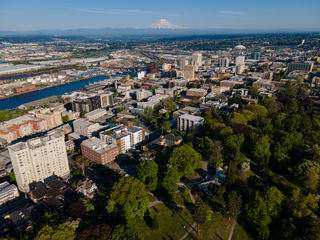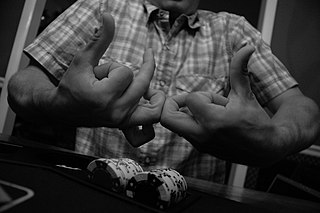
Tacoma is the county seat of Pierce County, Washington, United States. A port city, it is situated along Washington's Puget Sound, 32 miles (51 km) southwest of Seattle, 36 miles (58 km) southwest of Bellevue, 31 miles (50 km) northeast of the state capital, Olympia, 58 miles (93 km) northwest of Mount Rainier National Park, and 80 miles (130 km) east of Olympic National Park. The city's population was 219,346 at the time of the 2020 census. Tacoma is the second-largest city in the Puget Sound area and the third-most populous in the state. Tacoma also serves as the center of business activity for the South Sound region, which has a population of about 1 million.

The Bloods are a primarily African-American street gang which was founded in Los Angeles, California. The gang is widely known for its rivalry with the Crips. It is identified by the red color worn by its members and by particular gang symbols, including distinctive hand signs.

Kensington is a neighborhood in Philadelphia that belongs to Lower Northeast. As with all neighborhoods in the city, the lack of any official designation means the boundaries of the area vary between sources over time and are disputed among locals. Kensington, as most long-term residents view it, refers generally to the area consisting of Kensington, East Kensington, West Kensington, and Harrowgate. The adjacent Fairhill and Norris Square neighborhoods are more separate but may be included in Kensington; Fishtown and South (Olde) Kensington were historically included. The most conservative boundaries of the neighborhood, shown in the map below, are Front Street and 5th Street to the west, the Amtrak train tracks to the North, Trenton Avenue, the Trenton Avenue train tracks, and Frankford Avenue to the east, and Cecil B. Moore Avenue to the south.

The Stadium District is a neighborhood of the north end of Tacoma, Washington, USA. It is named after Stadium High School, a historic landmark.

The Rollin 60s Neighborhood Crips is a "set" of the Crips street gang alliance based in Los Angeles, California, originally formed around Hyde Park, Los Angeles in 1976 from the Westside Crips and having since spread to other cities in the United States. Membership is estimated to be around 1,600 people, making it one of the largest gangs in the Los Angeles area.

The Crips are a primarily African-American alliance of street gangs that are based in the coastal regions of Southern California. Founded in Los Angeles, California, in 1969, mainly by Raymond Washington and Stanley Williams, the Crips began as an alliance between two autonomous gangs, and developed into a loosely connected network of individual "sets", often engaged in open warfare with one another. Its members have traditionally worn blue clothing since around 1973.

The T Line, formerly known as Tacoma Link, is a light rail line in Tacoma, Washington, part of the Link light rail system operated by Sound Transit. It travels 4.0 miles (6.4 km) and serves 12 stations between Tacoma Dome Station, Downtown Tacoma, and Hilltop. The line carried 934,724 total passengers in 2019, with a weekday average of over 3,100 boardings. Tacoma Link runs for nine to 18 hours per day, using streetcars at frequencies of 12 to 20 minutes.
The municipal government of Winnipeg is represented by 15 city councillors and a mayor elected every four years.
In the late 19th and early 20th centuries, African American organized crime emerged following the first and second large-scale migrations of African Americans from the Southern United States to major cities of the Northeast, Midwest, and later the West Coast. In many of these newly established communities and neighborhoods, criminal activities such as illegal gambling and speakeasies were seen in the post-World War I and Prohibition eras. Although the majority of these businesses in African-American neighborhoods were operated by African-Americans, it is often unclear the extent to which these operations were run independently of the larger criminal organizations of the time.
West Columbus, sometimes referred to as westside or the West Side, is a neighborhood in Columbus, Ohio, United States. Unlike other Columbus neighborhoods, it is a broad geographical term used by locals rather than a subdivision or suburb. West Columbus is defined as the entire southwest side of Columbus, bordered on the north by interstates 70 and 670, within Interstate 71 on the east, and on the south and west by the city limits that reach several miles to the outside of the I-270 outerbelt. It covers the ZIP Codes 43223, 43204, 43228, and 43222.
Crime in Los Angeles has varied throughout time, reaching peaks between the 1970s and 1990s.
Gang activity and associated crime is a long-standing concern in Denver, Colorado. The city's street gang activity received statewide attention in 1993 when a "Summer of Violence" increased public awareness of gang-related violence and led the state to enact harsh penalties for crime by juveniles. From 1992 to 1995, Denver had 331 murders: 95 in 1992, 74 in 1993, and 81 each in 1994 and 1995 In 1997 The first Gang to ever be indicted out of Colorado was the West Side Ballerz Posse WSBP a Chicano gang that resided in West Denver & branched off in surrounding Adams county in cities such as Commerce, Thornton, Brighton, and Westminster. In 1996, members of the FBI's Metro Gang Task Force (“MGTF”) were investigating suspected gang-related drug activity in Denver, Colorado. Specifically, MGTF was investigating members of the West Side Ballerz Posse whom it suspected were selling controlled substances and engaging in gang-related violence. As part of this investigation, a series of wiretaps were authorized in late 1996 against suspected members of this drug conspiracy. Gang-related crime has continued, as shown by the New Year's Day 2007 drive-by shooting of Broncos cornerback Darrent Williams by members of the Tre Tre Crips, an East Denver street gang. The Crips in the city have several sub-sets such as Tre Deuce (DOD), Tre Foe, 35 Outlaws and the Tre Tre Gangstas. In 2017, the city's police estimated that there were 14,000 gang members in Denver, affiliated with 220 gangs. The Rollin 30s or Tre Tre Crips still have a powerful presence in the Denver area. In 2017 there were an estimated 2000 Bloods and Crips from Denver. These gangs are in various locations including Five Points, East Denver, Commerce City, Englewood, Aurora, North-East Park Hill and Federal Heights. Crips and Bloods have been commonly sighted almost all over Denver, even in the suburbs outside the city.

The Grape Street Watts Crips is a set of the Crips gang based in the Watts neighborhood of Los Angeles. The gang's rivalry with the Bounty Hunter Bloods has been described as being "the most violent and long lasting feud between two gangs that are in the Watts area."
Memphis, Tennessee serves as the Southern headquarters for Tennessee based street organizations in the Southern United States. In 2021, there were approximately 102 gangs with 13,400 gang members in the city.

The Tongan Crip Gang (TCG) is a Tongan American street gang that is a subgroup, or "set", of the Crips gang alliance. The gang is active in the U.S. states of California, Utah and Alaska and parts of Auckland, New Zealand.
The Florencia 13, also known as South Side Florencia 13,Florence Gang, F13 is an American criminal street gang based in Los Angeles, California, composed mainly of Mexican Americans. The gang is named after the Florence area of Los Angeles County, controlled by the Mexican Mafia. They are involved in drug smuggling, murder, assault and robbery.
The Ash Street shootout was a gunfight on September 23, 1989, in the Hilltop neighborhood of Tacoma, Washington, United States, between off-duty United States Army Rangers and people associated with one Ranger's across-the-street neighbors, who were suspected of drug dealing and gang activity. An already tense neighborhood situation, wherein Staff Sergeant Bill Foulk and others had been advocating for more police action against drug crime, came to a head during a barbecue at Foulk's home on Ash Street, attended by other community members and a few other members of the 2nd Ranger Battalion. Both groups of belligerents claim that the other harassed them during the party. Foulk called for assistance from more Rangers, who arrived with privately owned firearms. Starting at 9:20 PM, 12 or so Rangers and 15 to 20 people from across the street exchanged gunfire with handguns and long guns for five to thirty minutes until police arrived. It is unclear which group fired first; both sides blamed the other. The conflict ended without reported injury after 100 to 300 rounds were fired. Foulk initially affirmed this account, but since 2009 has said that one or more people on the other side were shot but fled.
The Crips and the Bloods, two majority-Black street gangs founded in Los Angeles (L.A.), California, have been engaged in a gang war since the 1970s. The war is made up of smaller, local conflicts between chapters of both gangs, and has mostly taken place in major cities in the United States, especially L.A. It is also present in other countries.














